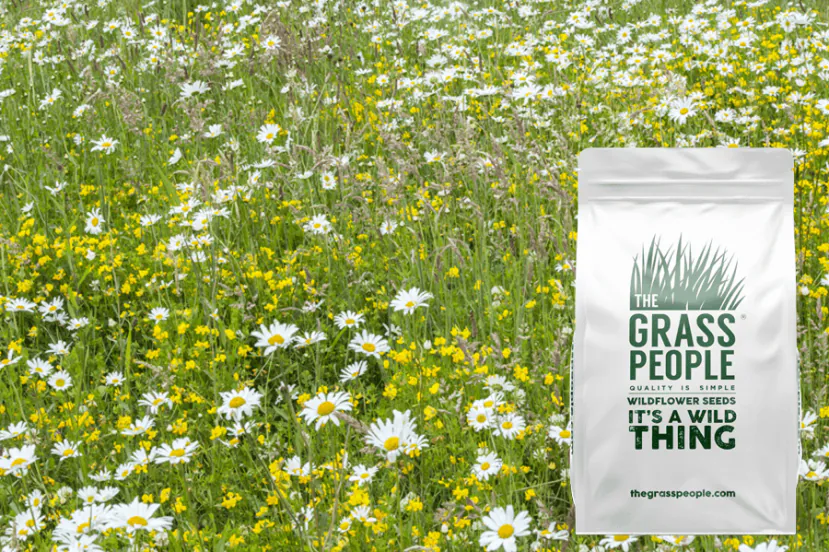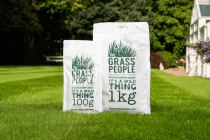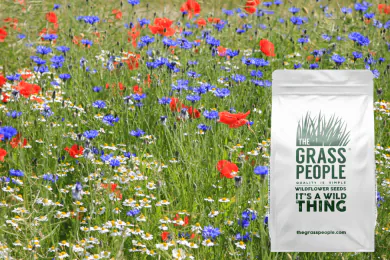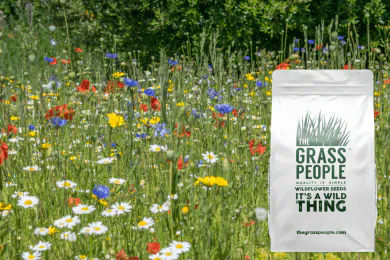Sandy Soils Wildflowers
- Low maintenance mix that thrives in sandy soils
- Contains a vibrant variety of annual and perennial wildflowers
- Suitable for use in road construction, sand pits and on free draining sites
Please refresh the page in 1 minute to see the next delivery time.
How much do I need?
Simply enter the length and width of the area, to calculate how much you need.
Product Description
Sandy Soils get a hard time for making it difficult to grow or establish plants or grass, but we know that with the right mix – an abundant wildflower meadow can be created within even the sandiest of soils! The wildflower species in this mix were picked for their unbridled ability to root, grow and thrive in sandy soils conditions, turning your sandy soil eyesore into a wildflower haven. As the species in this mix are RHS Plants for Pollinator approved, they are also a great source of food for bees and other pollinators.
Mixture Breakdown
June - September
What colour is it?Yellow
Annual or Perennial?Perennial
Latin NameGalium verum
DescriptionLady's Bedstraw used to be used in bedding due to its soft and springy texture! This is definitely a wildflower you'll want in your meadow... when you walk past it, it smells of honey.
June - August
What colour is it?Purple
Annual or Perennial?Annual
Latin NameGeranium pratense
DescriptionThis plant gets its name from the large, purple flowers that turn into bill-like seed pods. It is very popular among bees.
June - September
What colour is it?White
Annual or Perennial?Perennial
Latin NameDaucus carota
DescriptionPart of the carrot family, Wild Carrot smells like carrots but is not the kind of one you would want to eat. Its low nutrient and drought tolerant abilities make it ideal for sandy soils.
May – September
What colour is it?White / Yellow
Annual or Perennial?Perennial
Latin NameLeucanthemum vulgare
DescriptionImagine the daisy chain these would make! Oxeye Daisy is the largest member of the daisy family and its almost flat surface makes the perfect landing pad for bees and pollinators.
April - July
What colour is it?Yellow
Annual or Perennial?Annual
Latin NameMedicago lupulina
DescriptionDespite its name, Black Medick is actually a yellow wildflower that resembles a clover. Just like a clover, it is exceptionally good at attracting bees and pollinators and due to its 'sprawling' ability, is particularly good at thriving in clay soils!
May - September
What colour is it?Yellow
Annual or Perennial?Annual
Latin NameRhinanthus minor
DescriptionYellow Rattle can be used in existing meadows where meadow grasses have taken over. It helps to weaken these grasses to allow other wildflowers to flourish, and does this by locking its roots to those of the grasses, and therefore lessens their abundance.
June - September
What colour is it?Green
Annual or Perennial?Perennial
Latin NameReseda luteola
DescriptionWeld sprouts teeny tiny cream buds and has a tendency to appear near foot paths. Although it may not have as much flora as other wildflowers, the spikes on its small flowers are an excellent source of pollen and nectar for butterflies and bees.
May – September
What colour is it?Yellow / Red
Annual or Perennial?Perennial
Latin NameLotus corniculatus
DescriptionBirdsfoot Trefoil is part of the pea family and grows up to 35cm. It is well known for its yellow slipper like petals and red centre, which has given it the nickname of 'Eggs and Bacon'!
May - July
What colour is it?White
Annual or Perennial?Perennial
Latin NameAruncus dioicus
DescriptionThis plant has creamy-white flowers that grow well above the green foilage below.
June – September
What colour is it?Yellow / Orange
Annual or Perennial?Perennial
Latin NameAnthyllis vulneraria
DescriptionKidney Vetch is a bright yellow budding wildflower that sometimes gets the name Woundwort. Although this isn't the nicest nickname, it was once used for treating ailments, and of course - wounds.
May - August
What colour is it?White / Green
Annual or Perennial?Perennial
Latin NameRumex acetosa
DescriptionCommon Sorrel is a perennial plant that thrives in clay conditions. Although its leaves are green, they often turn red and pink offering a pop of colour to your meadow.
May - September
What colour is it?White
Annual or Perennial?Annual
Latin NameEuphrasia officinalis
DescriptionThis plant has oval leaves which are sharply toothed. It has white flowers with purple veins.
June - September
What colour is it?Violet
Annual or Perennial?Perennial
Latin NameEchium vulgare
DescriptionThe electric blue blooms of Vipers Bugloss are irresistible to bees and as its stamen’s stick out, they’re extra easy to get to. Offering a pop of colour to your meadow, you can be sure that this wildflower is a tourist attraction for bees far and wide.
May - August
What colour is it?Red
Annual or Perennial?Perennial
Latin NameRumex acetosella
DescriptionThis plant has a tall, upright stem with small red flowers emerging from the end.
June - September
What colour is it?Pink
Annual or Perennial?Perennial
Latin NameOriganum vulgare
DescriptionThis plant has oval leaves which form in neat clumps on the end of its reddish stems. It is very attractive to bees and other pollinators.
June – November
What colour is it?White / Occasionally pink
Annual or Perennial?Perennial
Latin NameAchillea millefolium
DescriptionYarrow produces clusters of white small-petalled blooms. It is an aromatic perennial making it particularly attractive to bees and pollinators who are enamoured by its sweet scent.
June - September
What colour is it?Yellow / Purple
Annual or Perennial?Perennial
Latin NameVerbascum nigrum
DescriptionDark Mullein is a very tall wildflower that is used to growing in dry places - so is ideal for sandy soils. We love its large yellow petals and purple centre.
This is a grass seed and typically germinates at temperatures of 8 -10 degrees
What colour is it?Green / Beige
Annual or Perennial?Perennial
Latin NameCynosurus cristatus
DescriptionCrested Dogstail is a grass that performs in most soil types
This is a grass seed and typically germinates at temperatures of 8 -10 degrees
What colour is it?Green / Beige
Annual or Perennial?Perennial
Latin NameFestuca arundinacea
DescriptionTall Fescue is a grass that performs in most soil types
This is a grass seed and typically germinates at temperatures of 8 -10 degrees
What colour is it?Green / Beige
Annual or Perennial?Perennial
Latin NameFestuca rubra
DescriptionStrong Creeping Red Fescue is a grass that performs in most soil types
This is a grass seed and typically germinates at temperatures of 8 -10 degrees.
What colour is it?Green / Beige
Annual or Perennial?Perennial
Latin NameFestuca rubra ssp. Commutata
DescriptionChewings Fescue is a grass that performs in most soil types
Usage Guide
● Remove any existing grass, plants or flora from the area where you plan to sow your wildflower seed. Failure to do this will produce poor results
● Further remove the top 5-10cm to reduce soil fertility
● Allow the area to cultivate for several weeks, and remove any weeds that may pop in the area during this time
● Do not be tempted to add top soil, compost or fertiliser to the area - wildflowers prefer low nutrient conditions
● After the cultivation period ensure to remove stones or any other debris and rake the area to create a fine, friable and level seedbed
● Scatter the seed at a rate of 5g per m2
● Rake the seed so that it is in amongst the soil
● Water the just-sown wildflower seed well
● If sowing in drought conditions, water as required to keep the area moist in the first 6 weeks after sowing
Read our full guide on how to manage your wildflower meadow here.
| Sowing Rate | 5 grams per m2 |
| When | For best results sow in September |
Aftercare
End of year cut:
- We recommend doing this essential end-of-year cut in autumn.
- Your wildflowers are ready for their first cut when they have grown to 7cm and have gone to seedhead.
- This cut can be done using your lawn mower at its highest setting or using a strimmer.
Early spring cut:
- An early spring cut is ideal when your wildflowers are well-established.
- This early spring cut trims back meadow grasses and helps increase the density of the wildflowers.
- This cut also encourages wildflowers to grow better later that season.
- Cut before the end of April, or you may stunt their growth, and they could skip blooming that year.
Summer cut (optional):
- A cut between June and August can encourage the growth of wildflowers later in the season.
- Cut back to 7cm tall and remove the cuttings.
- This optional cut encourages new wildflowers to grow and flourish.
What to do with the cuttings (if you have annual wildflowers in the mix):
In dry conditions:
- If conditions will be dry for 5-7 days, you can let the cuttings lie on the ground so the seeds drop.
- Walk over, use a roller or shake the seedheads to encourage the seeds to fall and grow next season.
- Then remove the plant cuttings after a week and dispose of them in your garden waste bin.
In wet conditions:
- Lift the clippings if rainfall is forecast, and manually free up the seeds by crushing the seedhead to collect the seeds for replanting.
- When dry conditions return, scatter the seeds across your wildflower area.
- Alternatively, you can store your collected wildflower seeds in an envelope and replant them later.
For further reading, check out our guide on when and how often to cut a wildflower meadow.
The above photo depicts the variety of species you should expect to see in your wildflower display. Please note that certain species within this mix and all our wildflower mixes may become more abundant than others, and this varies based on the conditions in which they are sown. Taking this into consideration, your wildflower meadow will evolve and adapt year after year and change in appearance as certain species may become more dominant than others.
Product Questions
Product Questions
Thanks Roisin
Thanks
Sandy Soils Wildflowers is the most suitable for this area. It is a mix of wildflowers that have the ability to root, grow and thrive in sandy soil conditions and tolerate soils that are free draining and prone to dryness. This mix contains annuals, perennials and grasses and majority of the wildflowers are perennials.
Below you will find our step by step guide on how to prep and sow a wildflower meadow but if you would like to email some photos of the area to [email protected], I can take a look and advise.
Thanks






